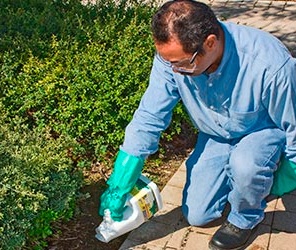Alifia Merchant: Determining Pesticide Exposure with Antibodies and 96 Tiny Wells

Agriculture and landscape workers apply pesticides as part of their work. Pesticides benefit us by protecting plants from harmful insects, but they can be poisonous if used carelessly.
Workers need to know how to safely use pesticides, such as by wearing gloves and long pants and washing their hands immediately afterwards. In California, many agriculture and landscape workers have a limited understanding of English and may not be able to read the instructions on how to apply pesticides safely. On the other hand, they may not have formal training through their employment, especially if their business is freelance. Even with trained workers, mistakes can be made.
My goal as a graduate student in the Agricultural and Environmental Chemistry Graduate Group at UC Davis is to help better protect agriculture and landscape workers from harmful pesticide exposure. I am working with Drs. Debbie Bennett and Bruce Hammock, Western Center for Agricultural Health and Safety (WCAHS) investigators, to develop quick and easy methods to determine if a worker has been exposed to pesticides.

I will interview agriculture and landscape workers to gain information about their jobs and possible pesticide exposure. Then, I will collect urine samples on days that they have sprayed or otherwise been exposed to pesticides.
Why am I collecting urine? When chemicals enter the body they can be metabolized, meaning that their chemical structure changes. After metabolism, the chemical can leave the body through urine. Different chemicals remain in the body for varying amounts of time, but the pesticides that I am studying are present in urine within several hours after exposure.
I will determine pesticide exposure using a method called enzyme-linked immunosorbent assay or ELISA for short. Each ELISA test involves a plate with 96 tiny wells with specific antibodies added to the wells. Each antibody detects a specific pesticide.
 Urine will be added to the wells. If a well contains urine with pesticide metabolites, the well turns light yellow or clear. If the urine does not contain pesticide metabolites, the well turns a bright yellow color. Thus, the color of the well allows us to know if a person has been exposed to a pesticide and to what degree.
Urine will be added to the wells. If a well contains urine with pesticide metabolites, the well turns light yellow or clear. If the urine does not contain pesticide metabolites, the well turns a bright yellow color. Thus, the color of the well allows us to know if a person has been exposed to a pesticide and to what degree.
In the future, we see using the ELISA to quickly know if someone has been unsafely exposed to a pesticide and needs medical help. It could also be used to train workers; if the ELISA shows that a worker was unsafely exposed to pesticides after applying them, the worker would be informed about their results and receive recommendations about how to better protect themselves while doing their job.
For information on how to safely use pesticides at work and home, check out The Pesticide Safety Project website and videos in both English and Spanish, produced by WCAHS in collaboration with the California Poison Control System, and the California Department of Pesticide Regulation.
